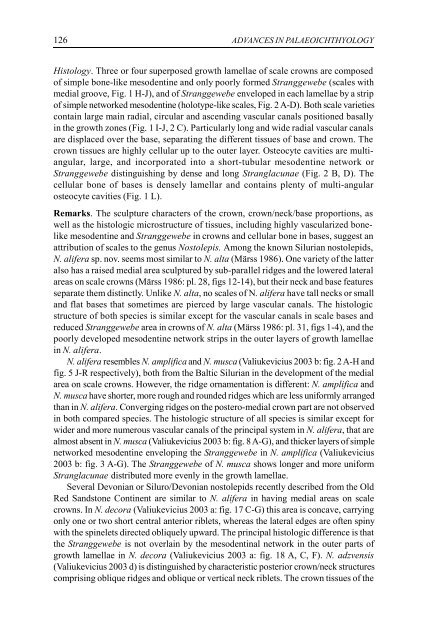Zemes un vides zinātnes Earth and Environment Sciences - Latvijas ...
Zemes un vides zinātnes Earth and Environment Sciences - Latvijas ...
Zemes un vides zinātnes Earth and Environment Sciences - Latvijas ...
You also want an ePaper? Increase the reach of your titles
YUMPU automatically turns print PDFs into web optimized ePapers that Google loves.
126<br />
ADVANCES IN PALAEOICHTHYOLOGY<br />
Histology. Three or four superposed growth lamellae of scale crowns are composed<br />
of simple bone-like mesodentine <strong>and</strong> only poorly formed Stranggewebe (scales with<br />
medial groove, Fig. 1 H-J), <strong>and</strong> of Stranggewebe enveloped in each lamellae by a strip<br />
of simple networked mesodentine (holotype-like scales, Fig. 2 A-D). Both scale varieties<br />
contain large main radial, circular <strong>and</strong> ascending vascular canals positioned basally<br />
in the growth zones (Fig. 1 I-J, 2 C). Particularly long <strong>and</strong> wide radial vascular canals<br />
are displaced over the base, separating the different tissues of base <strong>and</strong> crown. The<br />
crown tissues are highly cellular up to the outer layer. Osteocyte cavities are multiangular,<br />
large, <strong>and</strong> incorporated into a short-tubular mesodentine network or<br />
Stranggewebe distinguishing by dense <strong>and</strong> long Stranglac<strong>un</strong>ae (Fig. 2 B, D). The<br />
cellular bone of bases is densely lamellar <strong>and</strong> contains plenty of multi-angular<br />
osteocyte cavities (Fig. 1 L).<br />
Remarks. The sculpture characters of the crown, crown/neck/base proportions, as<br />
well as the histologic microstructure of tissues, including highly vascularized bonelike<br />
mesodentine <strong>and</strong> Stranggewebe in crowns <strong>and</strong> cellular bone in bases, suggest an<br />
attribution of scales to the genus Nostolepis. Among the known Silurian nostolepids,<br />
N. alifera sp. nov. seems most similar to N. alta (Märss 1986). One variety of the latter<br />
also has a raised medial area sculptured by sub-parallel ridges <strong>and</strong> the lowered lateral<br />
areas on scale crowns (Märss 1986: pl. 28, figs 12-14), but their neck <strong>and</strong> base features<br />
separate them distinctly. Unlike N. alta, no scales of N. alifera have tall necks or small<br />
<strong>and</strong> flat bases that sometimes are pierced by large vascular canals. The histologic<br />
structure of both species is similar except for the vascular canals in scale bases <strong>and</strong><br />
reduced Stranggewebe area in crowns of N. alta (Märss 1986: pl. 31, figs 1-4), <strong>and</strong> the<br />
poorly developed mesodentine network strips in the outer layers of growth lamellae<br />
in N. alifera.<br />
N. alifera resembles N. amplifica <strong>and</strong> N. musca (Valiukevicius 2003 b: fig. 2 A-H <strong>and</strong><br />
fig. 5 J-R respectively), both from the Baltic Silurian in the development of the medial<br />
area on scale crowns. However, the ridge ornamentation is different: N. amplifica <strong>and</strong><br />
N. musca have shorter, more rough <strong>and</strong> ro<strong>un</strong>ded ridges which are less <strong>un</strong>iformly arranged<br />
than in N. alifera. Converging ridges on the postero-medial crown part are not observed<br />
in both compared species. The histologic structure of all species is similar except for<br />
wider <strong>and</strong> more numerous vascular canals of the principal system in N. alifera, that are<br />
almost absent in N. musca (Valiukevicius 2003 b: fig. 8 A-G), <strong>and</strong> thicker layers of simple<br />
networked mesodentine enveloping the Stranggewebe in N. amplifica (Valiukevicius<br />
2003 b: fig. 3 A-G). The Stranggewebe of N. musca shows longer <strong>and</strong> more <strong>un</strong>iform<br />
Stranglac<strong>un</strong>ae distributed more evenly in the growth lamellae.<br />
Several Devonian or Siluro/Devonian nostolepids recently described from the Old<br />
Red S<strong>and</strong>stone Continent are similar to N. alifera in having medial areas on scale<br />
crowns. In N. decora (Valiukevicius 2003 a: fig. 17 C-G) this area is concave, carrying<br />
only one or two short central anterior riblets, whereas the lateral edges are often spiny<br />
with the spinelets directed obliquely upward. The principal histologic difference is that<br />
the Stranggewebe is not overlain by the mesodentinal network in the outer parts of<br />
growth lamellae in N. decora (Valiukevicius 2003 a: fig. 18 A, C, F). N. adzvensis<br />
(Valiukevicius 2003 d) is distinguished by characteristic posterior crown/neck structures<br />
comprising oblique ridges <strong>and</strong> oblique or vertical neck riblets. The crown tissues of the
















